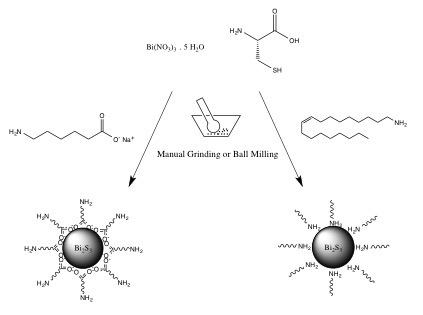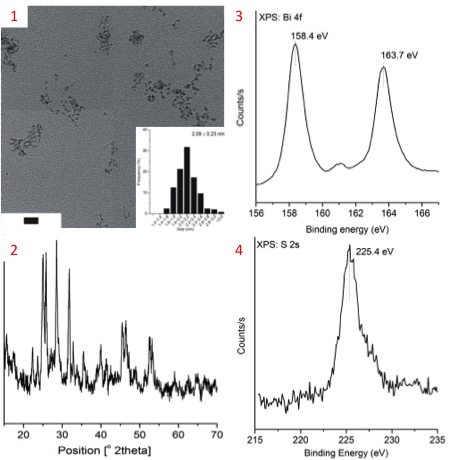Metal-based nanoparticles (NPs) have shown vast potential and rapid advancement in applications including electronics, optics, catalysis and public health products. While their properties are very exciting and inspire many research groups, the impact of their synthesis on the environment and health is often neglected in the search for purer and better-defined products. In an effort to reduce synthetic footprints in nanoscience, we developed a novel method for the scalable mechanochemical production of bismuth sulfide NPs (Figure 1), which have demonstrated efficacy as contrast probes for X-ray Computed Tomography imaging [1]-[3]. These particles have also proven valuable as radiosensitizers for the targeted treatment of superficial tumors [4]. Organic (~ 2 nm, Figure 2) and aqueous (~8 nm) suspendable NPs were synthesized using oleylamine (OA) and sodium 6-aminohexanoate (AHA) as ligands, respectively. We have also devised, for the first time, a one-step mechanosynthesis of PEGylated Bi2S3 NPs (~ 4nm) using Poly-(ethylene glycol)-methyl-ether-amine (mPEG-Amine, mw=5000) as an initial reagent. The combined use of mPEG-Amine and AHA afforded both biocompatible and surface-functionalized NPs, which can then be further modified for tailored applications. The NPs are accessed through a bottom-up approach from Bi(NO3)3-5H2O, using L-cysteine as a sulfur source. Ball milling, as well as mortar and pestle grinding both proved to be effective synthetic methods. Interestingly, the milling duration and ligand-to-bismuth ratio were shown to have no significant effect on the mean diameter of the obtained OA-capped NPs. The radiodensity of the AHA- and AHA-mPEG-capped NPs were characterized through µCT imaging. In vitro cytotoxicity screening of the PEGylated NPs was also performed. This novel method allows access to gram-scale quantities of monodispersed NPs in a green and economical fashion. The NPs obtained may provide a unique means for targeted tumor indentification and therapy.


Mary Bateman; Thomas Bastaille; Nadim K. Saade
References:
[1] Kinsella JM, Jimenez RE, Karmali PP, Rush AM, Kotamraju VR, Gianneschi NC, et al. X-Ray Computed Tomography Imaging of Breast Cancer by using Targeted Peptide-Labeled Bismuth Sulfide Nanoparticles. Angew. Chem. Int. Ed. 2011, 50(51): 12308-12311.
[2] Rabin O, Manuel Perez J, Grimm J, Wojtkiewicz G, Weissleder R. An X-ray computed tomography imaging agent based on long-circulating bismuth sulphide nanoparticles. Nat. Mater. 2006, 5(2): 118-122.
[3] Ai K, Liu Y, Liu J, Yuan Q, He Y, Lu L. Large-Scale Synthesis of Bi2S3 Nanodots as a Contrast Agent for In Vivo X-ray Computed Tomography Imaging. Adv. Mater. 2011, 23(42): 4886-4891.
[4] Su M, Hossain M. Nanoparticle Location and Material-Dependent Dose Enhancement in X-ray Radiation Therapy. J. Phys. Chem. C 2012, 116, 23047-23052.